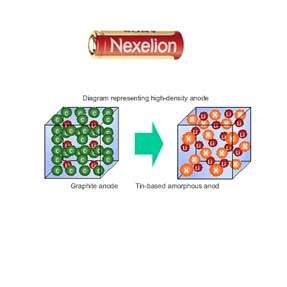Industry's First Tin-Based Anode Battery With 30 Percent More Capacity

With the growing demand for smaller digital devices with increased functionality, the trade-off-until now-has been battery life. Sony Corporation today announced the industry's first hybrid lithium ion rechargeable battery. Dubbed NexelionTM the new battery utilizes a tin-based amorphous anode; translating into a 30% increase in the capacity per volume ratio compared to conventional lithium-ion batteries, and will be commercialized initially as a battery pack for Handycam® camcorder products.
Instead of using graphite-based materials for the anode as found in conventional batteries, Sony incorporated a tin-based amorphous anode material where the lithium ion storage capacity per volume ratio has been increased by 50%, which increases the overall battery capacity by 30%.
At Sony, ever since the commercialization of lithium ion secondary battery in 1991, the battery capacity has more than doubled from the enhanced performance of carbon based materials and other materials to be used in the anode, as well as improvements in the structure of the battery," said Masayuki Nagamine, deputy general manager of Sony Corporation's Energy Company." The newly developed tin based amorphous material is a high capacity anode material which will take the lead of the next generation lithium ion secondary battery. Technological development will be carried on, to further increase the capacity of batteries, to deal with enhanced performance as well as longer operating time of the products."
"While tin and silicon, or compounds which include these elements, enable high capacity in lithium-ion rechargeable batteries, their propensity for change in particle shape during the charge and discharge phases was drastic, requiring an improvement in the characteristics of deterioration at recycling for commercialization. Sony's development of the tin-based amorphous anode, along with a new cathode, electrolyte and battery structure, has resulted in a new generation of lithium-ion batteries with higher durability and capacity. Additionally, the Nexelion battery offers improved charge and discharge at low temperatures and quicker recharge times.
Key Features of 'Nexelion' hybrid lithium ion rechargeable battery:
1. Tin-Based Amorphous Anode
The newly developed tin-based amorphous anode is a material consisting of multiple elements such as tin, cobalt, carbon, where the elements are mixed on a nanometer level-as opposed to conventional batteries which use carbon-based materials such as soft and hard carbons, as well as graphite. By adding several elements to the tin based compound, Sony has been able to minimize the change in particle shape during charge and discharge, solving the problem of cycling characteristics. The result is a 50% higher unit per volume ratio of lithium ion density compared to the conventional graphite anode, resulting in dramatic increase in the density.
2. Multi-stage Composite Cathode
In the cathode, multiple metal atoms such as cobalt, nickel, and manganese are incorporated in the crystal structure in an optimized atomic ratio to form a multi-metal oxide material, and this is then added in the equally optimized, high-temperature resistant Lithium. By introducing this multi-stage composite cathode, Sony managed to realize a higher capacity with the same charging voltage. Also, excess discharge can be avoided, resulting in greater battery reliability.
3. Enhanced Low-Temperature Characteristics
90% of the Nexelion battery's fully-charged capacity can discharge at 0°C or at room temperature (25°C). In addition, at minus 20°C the discharging capacity has increased by 40% (the discharge of the conventional battery is 450mAh), which allows improved video shooting time in ski resorts and in winter leisure timing.
4. Enhanced Charging Efficiency
Compared to the graphite anode of the conventional battery, the Tin based amorphous anode has a higher affinity of lithium ions, and from this, the charging efficiency has increased by 20% compared to the conventional battery. 90% of the Nexelion battery's capacity can be charged in approximately 30 minutes.


















